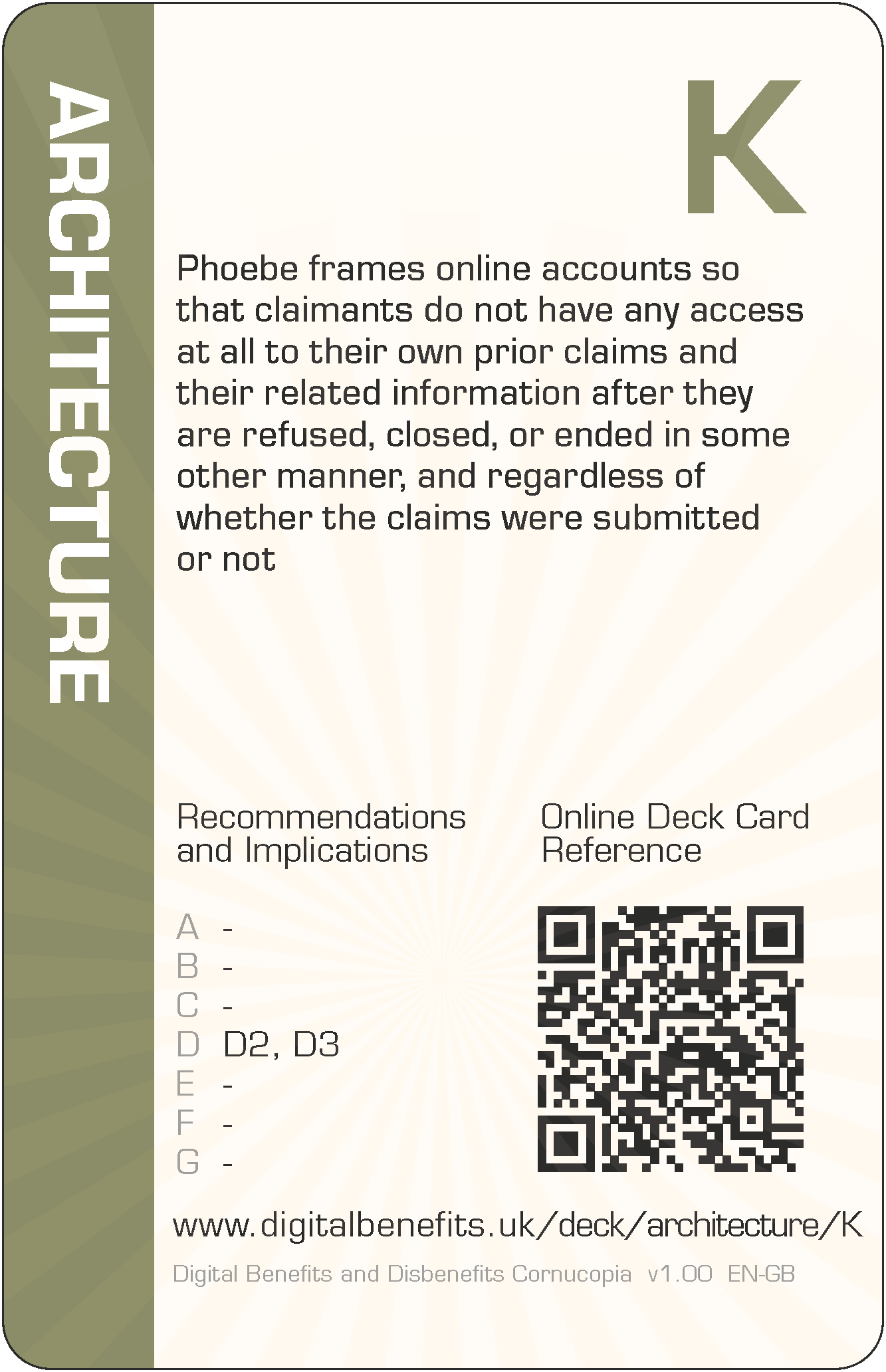Architecture K (AR-K) Card
DBD Cornucopia > Deck > Architecture > K
Card Details - King of Architecture
Abbreviation
AR-K
Card's focus
The focus of this card is data retention and access
Threat to claimants
Phoebe frames online accounts so that claimants do not have any access at all to their own prior claims and their related information after they are refused, closed, or ended in some other manner, and regardless of whether the claims were submitted or not

Threat to claimants
Phoebe frames online accounts so that claimants do not have any access at all to their own prior claims and their related information after they are refused, closed, or ended in some other manner, and regardless of whether the claims were submitted or not.
Some examples of how this threat could lead to harms (negative effects on claimants)
The design recommendations and implications relevant to the card are listed below in the next section, but even those can be somewhat abstract and difficult to think about during practical day-to-day implementation. Therefore, some example harms are provided to complement the more formal research outputs. These examples are unique per card, and are only published on these web pages (i.e. in no other project outputs).
- There is no way for claimants to view all information about the most recent claim, or previous claims, making it harder to understand why a claim has been closed, very awkward to keep records for future use, and more difficult to question a decision, complain or appeal
- When claimants transition from one similar welfare benefit to another (e.g. due to age), their past history and information is unavailable to them, requiring claimants to keep their own records and evidence to use to make the new claim
- There are no data access permissions defined in the database for claimants once a claim is closed, requiring claimants to submit subject access requests to get access to information about their previous claims held by the system
- Claimants are forced to make new claims towards the end of an award, and to do so in full, without being provided with any of the information pertaining to their current claim, adding to the amount of time and effort they need to spend
- Interim award reviews request claimants to detail if anything has changed since the original claim was made, but the original information is not provided to compare with claimants' current status, making it difficult for them to answer accurately
The examples are to help understand the threat on the card, not to suppress thinking and innovation. Incorporating these examples exactly, or closely matching ones, should be scored down when playing DBD Cornucopia as a game.
Applicable design recommendations and implications
These are reproduced here from Research Briefing N
Embrace a wider ecosystem and fuller claimant activity viewpoint for digitised public services
- Design for the needs of claimants’ lives covering their expansive activities
Recognise that service take-up requires more than direct interactions with the state. Ensure design is not restricted to service delivery between interaction points of claimants and the state within a 'user journey', and instead span all actors and mediating instruments that come together to achieve the claimant's goal. - Use claimant-related policy outcome measures to assess digitisation
The most relevant factors of success of digital transformation are metrics based on the intended purpose of the policy rather than focusing on state-incurred financial costs. The advantages of digitised policy implementation must be balanced with the gains and harms across the whole ecosystem from the viewpoint of claimants.
General Notes
Card values (i.e. 'King' for this card) are for game play and are not correlated with the severity of harm. This is because threats cannot be ranked directly since they can affect individuals in different ways due to situations and circumstances, or affect fewer or more claimants, or the harms can arise in claimants' support networks and wider society.
The threat description uses a person's name as the "attacker" (i.e. 'Phoebe' for this card), which can be thought of someone involved with implementation. They could have any role which influence digitisation. So they could be a database administrator, or a copy writer, or a quality assurance specialist, etc, or all of these. Everyone could have some influence on the claimant threat described. The names were randomly selected from those currently most popular as given names for boys and girls (UK Office for National Statistics).
The example harms provided are drawn from the research data (which explored not only parts of existing services but also the effects of possible changes to those), from the author's own knowledge of web application development and testing, the author's own experience of helping citizens to claim Universal Credit (UC) and Personal Independence Payment (PIP), and from suggestions submitted by other people (make a suggestion). The threats and example harms do not necessarily exist in the current UC or PIP deployments or in ecosystems around those services, but they might well do.
All the cards in this Architecture suit are: 2 3 4 5 6 7 8 9 10 J Q K A
The other suits in the deck are: Scope, Agency, Trust, Porosity and Cornucopia (plus Jokers).
